Education Menu
![]()
Go to Part 1 Part
2 Part 3 Part
5
 From an air pollution perspective,
diesel automobiles are bad news. This quote is from a leading
EPA scientist who has been studying particulates for a long time.
From an air pollution perspective,
diesel automobiles are bad news. This quote is from a leading
EPA scientist who has been studying particulates for a long time.
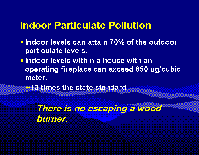 Because houses "breathe"
there is always seepage of outside air into the house; therefore,
it is not possible to isolate yourself from high exterior particulate
levels. Remember, the most dangerous particles are are too small
to be smelled. If you are burning inside the house the PM10 reading
will go very high - exceeding the state standards by 13 times.
Because houses "breathe"
there is always seepage of outside air into the house; therefore,
it is not possible to isolate yourself from high exterior particulate
levels. Remember, the most dangerous particles are are too small
to be smelled. If you are burning inside the house the PM10 reading
will go very high - exceeding the state standards by 13 times.
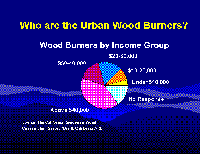 Most of the burning is done
by upper middle class households. This explains part of the permissive
attitude of governmental agencies; they do not want to offend
middle class voters. Some of the smokiest neighborhoods are affluent
neighborhoods that emphasize family values and a good environment
for raising children.
Most of the burning is done
by upper middle class households. This explains part of the permissive
attitude of governmental agencies; they do not want to offend
middle class voters. Some of the smokiest neighborhoods are affluent
neighborhoods that emphasize family values and a good environment
for raising children.
 Pacific Gas&Electric
in 1992, estimated that to be economically competitive with natural
gas wood would have to be available for less than $70 per cord.
In Los Altos, CA a cord of dried hardwood delivered but not stacked
is priced at $235. At those prices two things can be asserted:
(1) RWB is a recreational lifestyle choice --what people moved
to the suburbs for. (2) People are willing to burn most anything
garbage, yard waste, scrap construction materials, etc. We know
of a neighbor who uses discarded roofing shingles with flame retardant
and insect treatment as kindling in his fireplace.
Pacific Gas&Electric
in 1992, estimated that to be economically competitive with natural
gas wood would have to be available for less than $70 per cord.
In Los Altos, CA a cord of dried hardwood delivered but not stacked
is priced at $235. At those prices two things can be asserted:
(1) RWB is a recreational lifestyle choice --what people moved
to the suburbs for. (2) People are willing to burn most anything
garbage, yard waste, scrap construction materials, etc. We know
of a neighbor who uses discarded roofing shingles with flame retardant
and insect treatment as kindling in his fireplace.
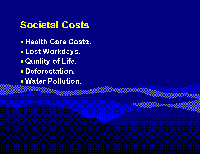 In addition to the direct
costs there are the indirect costs to society: medical costs and
lost work days, among others. It is estimated that in the San
Francisco Bay area the yearly cost of particulate fine pollution,
from health and lost wages runs to as much as two billion
dollars annually. Over one billion of this expense is directly
related to the smoke pollution caused by those who burn wood.
In addition to the direct
costs there are the indirect costs to society: medical costs and
lost work days, among others. It is estimated that in the San
Francisco Bay area the yearly cost of particulate fine pollution,
from health and lost wages runs to as much as two billion
dollars annually. Over one billion of this expense is directly
related to the smoke pollution caused by those who burn wood.
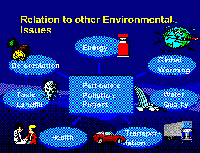 RWB is related to all of
the environmental problems in this slide. The ash dioxin and chemicals
released in wood burning leach into the soil and into the water
supply. The cutting trees for fuel adversely affects runoff, flooding
and watersheds. The release of greenhouse gasses effect global
warming. We live in a very connected world sometimes called Spaceship
Earth.
RWB is related to all of
the environmental problems in this slide. The ash dioxin and chemicals
released in wood burning leach into the soil and into the water
supply. The cutting trees for fuel adversely affects runoff, flooding
and watersheds. The release of greenhouse gasses effect global
warming. We live in a very connected world sometimes called Spaceship
Earth.
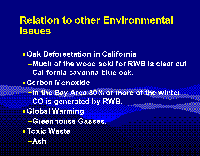 An elaboration of the problems
depicted in the last slide.
An elaboration of the problems
depicted in the last slide.
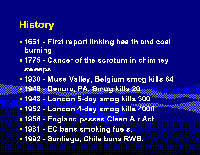 The problems have been known
for a long time. It is just that most people including governmental
regulators choose to ignore them.
The problems have been known
for a long time. It is just that most people including governmental
regulators choose to ignore them.
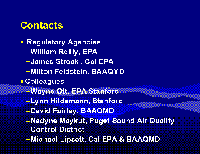 A partial list of contacts
who have supplied valuable information to Burning Issues.
A partial list of contacts
who have supplied valuable information to Burning Issues.
